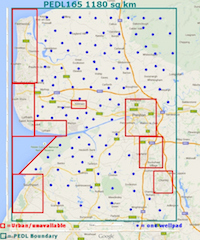How things have changed!
Let’s take a step back in time shall we.
Imagine you are back in 2012 in a packed hall in St Annes listening to a panel debate between the regulators, Cuadrilla, Friends of the Earth and local engineer Mike Hill. Somebody suggests that fracking in the Fylde will require maybe as many as 80 wells to be drilled (that’s wells not well pads by the way). Mark Menzies MP (Fylde, Con) is asked his opinion and states that he would not be able to support a development of that size.
Now let’s skip forward a bit to July 2015 where we have Kevin Hollinrake MP (Thirsk and Malton, Con) stating categorically that he insists on a 6 mile separation between fracking wells.
As we move forward yet again to yesterday’s meeting of the APPG on shale gas regulation and planning, it hardly seems credible that we now hear these two MPs calling for a limit of 8-10 pads in a 100km2 block.
Mr Menzies even went as far as to say:
“You need to have conversations with government. If you are confident that with new technology you can extract enough gas without going all over the place. This is about reassuring people. If we do not get something like this, you guys are stuffed. ”
But what does 8-10 pads in a 100km2 block actually mean? Well Cuadrilla’s licence area is 1200km2 in round numbers, so this would mean a limit of 120 well pads. And Mr Menzies thinks we’d find that reassuring? Really?
Regular readers of this site will recall that we have already addressed the question of te potential impact of 4000 wells on just 100 well pads (https://www.refracktion.com/index.php/so-what-would-100-40-well-pads-look-like-numerically/)
Some of you may even remember the outrage from the industry and its supporters when this map was produced showing just 100 (not 120 pads)

So why, we have to ask ourselves, are these two MPs seeming to suggest that 10 well pads per 100 km2 is an acceptable limit? Mr Menzies said he couldn’t support 80 wells in his area – that would be just 2 well pads, not 120. Mr Hollinrake was emphatic about the need for a 6 mile separation between wells, but now he seems happy to accept just 2 miles.
It is quite inconceivable that an industry which claims t be able to drill 5 mile laterals could want (or manage) spacing between wells of less than 2 miles, so all we are seeing here is a political dance.
2 MPs appear to be doing something, but when you analyse what they are in fact proposing it has no substance whatsoever. (How surprised are we at that?). It would appear that they are in fact proposing a “limit” which their friends in the fracking industry would find in no way challenging. The industry will no doubt acquiesce after some pantomime grumbling and our two politicians will bask in the glory of having “achieved” something, whilst the industry will tell us how reasonable they have been.
Just remember, however, what Cuadrilla told the Advertising Standards Authority whilst wriggling out of an accusation that their claim that
“Some critics have suggested that the area would be blighted by densely packed, unattractive developments in the future, if we moved to production stage. This would not be the case”
was misleading. The ASA reported that Cuadrilla claimed:
If it were to proceed it could entail in the order of 10 to 20 development pads across the 1200 km2 area of the licence, with each pad approximately the size of a football pitch. They argued that the size and amount of wells would be considerably less than some sites in the US, which were often cited by opponents to hydraulic fracturing operations. They maintained that field development in the UK did not mean populating the countryside with new drilling locations; horizontal wells could radiate from the same well bore like the tines of a fork and in several directions, which could be repeated at different levels. One pad could manage 24-36 horizontal wells using present day technology.
CRL said judging what would be “densely packed” was a matter of opinion and a subjective issue. They had used the term density to mean the number of sites per unit of area. They said, as the licensed operator, they were responsible for proposing the development, which they did not intend to be densely packed. They said the level of attractiveness was not capable of objective substantiation.
So Cuadrilla claim only to need 20 pads in 1200 km2 or 10 pads every 600 km2. Having to agree to a maximum density of 10 pads every 100 km2 would hardly be a challenge then would it? – Unless the ASA and the public were being misled there of course?
Finally Mr Menzies apparently also said there had been “enormous advances” in legislation and regulation of shale gas over the past six years. We would love him to explain to us exactly where those have occurred. I have written to him today
Dear Mark
I have now read the report of the APPG meeting on https://drillordrop.com/2016/09/07/fracking-companies-urged-to-limit-number-of-well-sites-to-reassure-residents/
I am non-plussed that, being on public record as stating that you could not support a development of 80 wells (not pads, wells) you are now proposing a maximum density which would allow 120 pads with up to 4000 (FOUR THOUSAND) wells in PEDL 165. Can you please explain how this can possibly be in the best interests of your constituents?
I also note that you referred to “enormous advances” in legislation and regulation of shale gas over the past six years. Would you be kind enough to clarify exactly what “enormous advances” you were referring to there?
Kind regards
and will publish any reply I get.
































